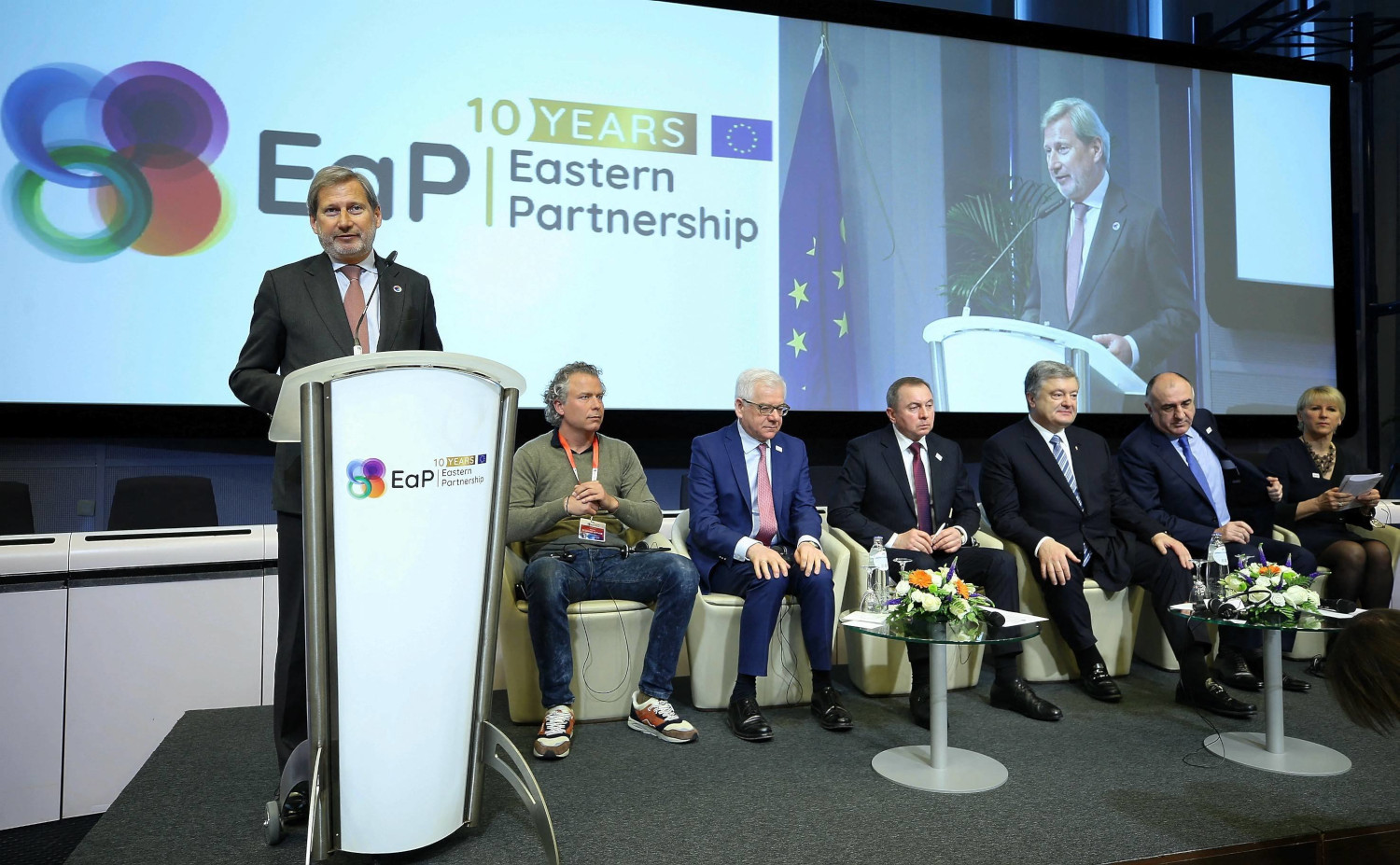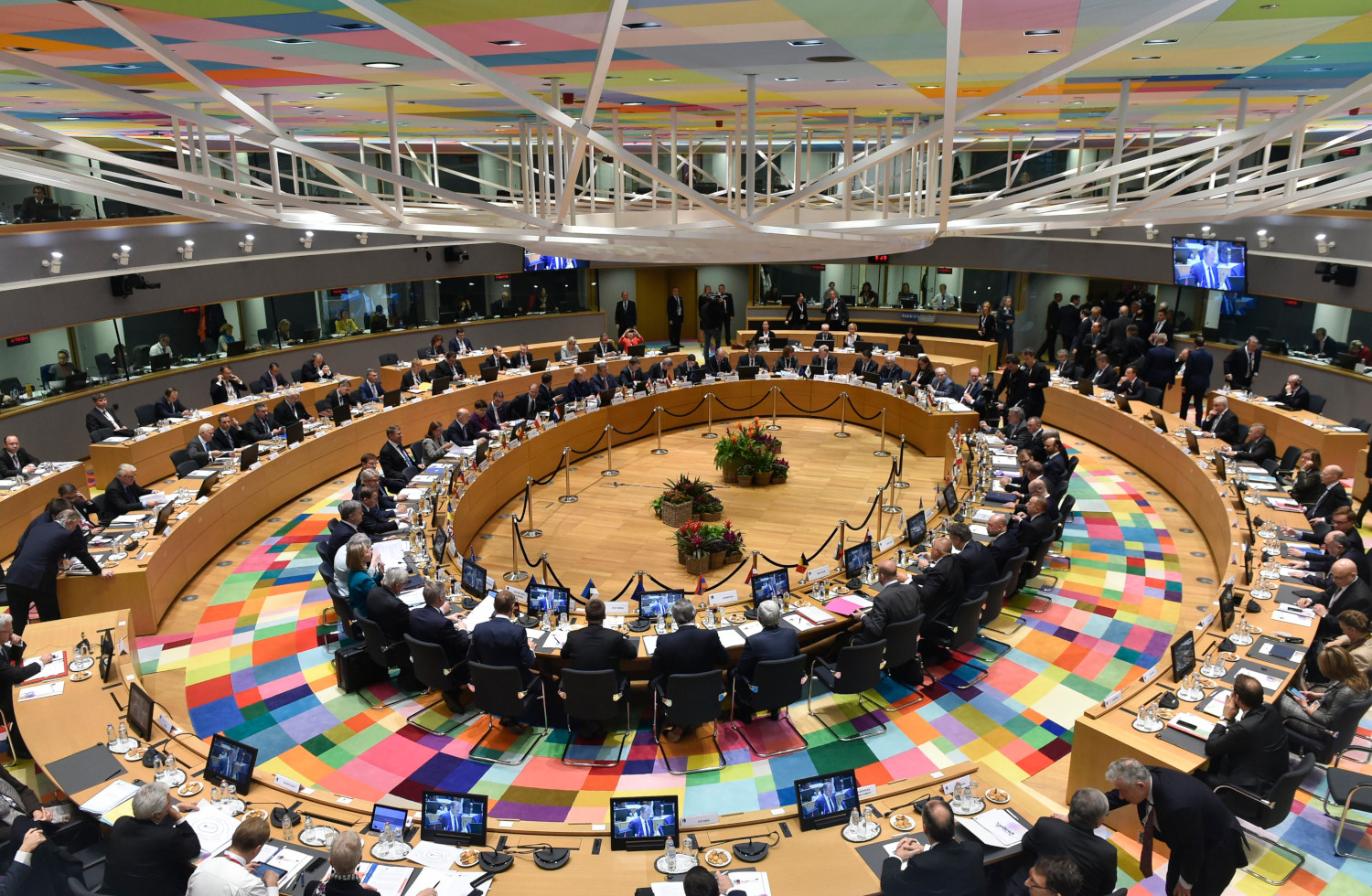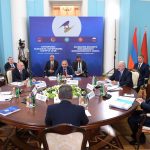THE WARSAW INSTITUTE REVIEW
Date: 4 November 2019 Author: Mateusz Kubiak
What is the future of the Eastern Partnership?
The 10th anniversary of the Eastern Partnership (EaP) celebrated in 2019 is not only the time for summaries but also for discussions regarding the form of further cooperation between the EU and its eastern neighbors. Even though there is a prevailing belief that the initiative launched by Poland and Sweden should be developed further, both among the addressees of the EaP and the EU members, there are serious discrepancies in the visions of further integration. In the face of no prospects of presenting the Eastern Partnership members with a possibility to access the EU, the significance of the sectoral cooperation, e.g., construction of the infrastructure or liberalization of markets, increases considerably in relevance.
 EU-Commissioner for European Neighborhood and Enlargement Negotiations, Johannes Hahn (L) speaks at the 10th anniversary of the Eastern Partnership (EaP) High-level conference in Brussels, Belgium, May 14, 2019. © Dursun Aydemir/Anadolu Agency (PAP/Abaca)
EU-Commissioner for European Neighborhood and Enlargement Negotiations, Johannes Hahn (L) speaks at the 10th anniversary of the Eastern Partnership (EaP) High-level conference in Brussels, Belgium, May 14, 2019. © Dursun Aydemir/Anadolu Agency (PAP/Abaca)Dramatic plot twists marked the decade of the Eastern Partnership’s history – it is sufficient to recall the Ukrainian Revolution of Dignity and the overthrow of Viktor Yanukovych, or an unexpected decision of the Armenian authorities to shift from the alliance with the EU to the Eurasian Economic Union developed by Russia. Nevertheless, the past decade includes the enhancement of the cooperation between the European Union and the EaP states and co-action in many sectoral policies as well. So what has been achieved so far, and how should further needs of the EU neighbors be defined? And is it possible to reconcile the interests of the EU states with expectations of the addressees of the Eastern Partnership?

Balance of the decade
ResultsR of the Eastern Partnershipought to be assessed through the prism of the fundamentals for this EU policy principle of “differentiation” as what may be considered as the success of the EaP in the case of Belarus or Azerbaijan (notably, Armenia is deliberately not mentioned here), may be of much smaller, or even zero significance in the case of states such as Georgia, Ukraine or Moldova. Today, these differences are even bigger than a decade ago when the Eastern Partnership was formed.
When it comes to the group of the so-called “EaP’s top states” – Georgia, Ukraine, and Moldova – it is necessary to stress the exhaustion of the recent program of cooperation at the political level. All countries aforementioned have already managed to sign European Union Association Agreements (AA) and Deep and Comprehensive Free Trade Agreements (DCFTA), as well as introduce the short-stay visa-waivers. Of course, a lot may be questioned in the matter of implementation of particular records. The stability of the pro-Western course of Moldova is raising concerns as well. However, it is a fact that in the case of the said group of the EaP members, the expectations go further than the EaP’s agenda projected: Kiev, Tbilisi and – to a lesser extent – Chisinau are already applying for the EU membership. It sufficessuffices to say that, for example, in July 2019, Georgian President Salome Zourabichvili proposed to open the accession negotiations with no preconditions, and, in the past, Ukraine threatened with blocking a joint declaration at the EaP summit as it lacked the issue of prospects for the EU membership.
In contrast, Azerbaijan and Belarus remain much more skeptical about the sense of the complex integration with the European Union and participation in the EU policy of the Eastern Partnership. In practice, authorities in Baku and Minsk treat the EaP’s offer selectively and are instrumentally picking the elements convenient for them. As a result, the prospects of the development of cooperation between Azerbaijan, Belarus and the EU should be considered mainly in the context of selected sectoral policies, not as possible integration at the strictly political level.
Armenia, whose case is the least obvious of all six EaP member states, is the last addressee state of the Eastern Partnership. It is necessary to underline that yet during the previous governance (before the change of leadership in Spring 2018) and the presidency of Serzh Sargsyan, Yerevan was actively aiming to sign the Association Agreement with the EU. Eventually, Armenia abandoned this goal in 2013 under the pressure of Russia which has been gathering instruments for exerting influence on the authorities in Yerevan for years. As a result, Armenians were also forced by Moscow to enter the Eurasian Economic Union which, in fact, does prevent them from the liberalisation of trade with the EU. Nevertheless,in 2017, Armenia managed to sign a Comprehensive economic partnership agreement (CEPA, still ratified in the EU states). Even though it does not provide for, e.g. the establishment of a free-trade area, in practice, it is in essence an equivalent of the Association Agreement prepared for Armenia and in case of its implementation – it should result in a relevant integration of Armenia with the EU.

Searching for political incentives
Despite formal consensus about the necessity of the Eastern Partnership’s existence, there is no doubt that it is seen in various ways by the EU members as well. This situation is not surprising considering the discrepancies between European perceptions of, for instance, political processes happening in the region. DifferencesD in perceiving the international environment, including the role of the Russian Federation in the region of the former Soviet Union, have to influence the willingness of the states to bear the cost (including political ones) of involvement in the development of the Eastern Partnership.
NEWSLETTER
The main point, which is definitely dividing the EU states, is the further development of the Eastern Partnership’s political dimension and the possible eastern enlargement of the EU in the future. Naturally, the official union policy of the EaP has never provided for the promise of membership. But the fact is that in the face of Euro-Atlantic aspirations of Georgia, Ukraine and possibly Moldova, this issue is inevitable and sooner or later it will have to be addressed by the EU. Further postponement of official statements regarding the possible enlargement of the European Union will increase frustration among part of Eastern Partnership member states: a similar situation has been happening for several years in the case of Georgia’s accession to the North Atlantic Alliance.
How can we mitigate the potential threat of discouragement of the Eastern Partnership members today, in the face of prevailing lack of political willingness to enlarge the European Union to the East? What kind of political encouragement should be sought for to keep the EaP’s program attractive also to “ordinary citizens” in countries such as Georgia or Ukraine?
One proposal has been formulated in recent months by Polish diplomacy, which presented the idea of extending the Association Agreements and reinforcing the institutionalization of the Eastern Partnership. Polish Minister of Foreign Affairs, Jacek Czaputowicz, in particular, appealed to consider the establishment of a kind of Eastern Partnership’s secretariat together with the introduction of the rotating presidency within the EaP. In theory, these actions should bring the eastern EaP partners closer to the decision-making processes in Brussels and increase their sense of belonging to the EU community. These ideas seem to be necessary, but at the same time, even in just a few years, they will not be sufficient to fill the gap left by the lack of the slightest prospect of the European Union membership.
Support Us
If content prepared by Warsaw Institute team is useful for you, please support our actions. Donations from private persons are necessary for the continuation of our mission.
 A view over the EU Eastern Partnership Summit in Brussels, Belgium, November 24, 2017. © John Thys/POOL (PAP/EPA)
A view over the EU Eastern Partnership Summit in Brussels, Belgium, November 24, 2017. © John Thys/POOL (PAP/EPA)Prospects of the sectoral cooperation
Another field of integrating with addressee countries of the Eastern Partnership is the sectoral cooperation. Naturally, for the most ambitious EaP members, this will not substitute for the possible EU membership. However, in theory, its development remains vital – it aids providing stability in the region as well as gives real business opportunities for EU capital tootoo. What is more, the agenda of the sectoral cooperation within the Eastern Partnership has already been highly developed, and in contrast to the mentioned political cooperation, it will not be exhausted too soon.
It is impossible to focus on all possible fields of the sectoral integration within the Eastern Partnership. However, the energy industry and transport may be considered especially pertinent (which is important – also for the public opinion within the EaP states). In both cases, there is still great potential for market reforms or investments in infrastructure. These are strategic sectors crucial for the development of the states, which influence the living standard of the “ordinary citizens” alsoalso, as they are of major importance for the prospects of the trans-boundary cooperation in the region.
If only a willingness of the EU member states occurs, the EU will be able to get involved more actively in the financial support for the infrastructural projects aiming to integrate the states in the region. Of course, such aid – e.g., for the construction of gas interconnectors, electro-energetic connections, or trans-boundary transport corridors – would have to be encumbered with many conditions. According to the “more for more” rule, beneficiaries of possible EU funds would have to ensure the liberalization of their markets by adopting the EU regulations. Otherwise, the transposition of the EU standards, for example in the energy industry, can cause many problems, which is already visible in the case of Ukraine, Georgia and Moldova. And every further encouragement can additionally stimulate these processes.
Of course, this vision is rather optimistic – it does not include many objective factors, such as influences of oligarchs or the Russian Federation on particular sectors in the EaP member states, and subjective, such as lack of willingness of many EU member states to provide considerable funds for the needs of their eastern neighbors. The fact is, however, that the members of the Eastern Partnership are talking about such financial support, and this fact only should spark off a debate whether we are able to address these expectations.
***
The European Union is now facing the necessity to find a response to the open question about the future of the Eastern Partnership after 2020 at the level of both political and sectoral cooperation. From the perspective of the Central and Eastern Europe countries, it is rather obvious that the worst that can happen to the EaP policy at the current stage would be stagnation and preservation of the current offer without any extension. This may be a cliché, but it is worth stressing that geopolitics abhors a vacuum, and if the citizens of the Eastern Partnership member states are to remain enthusiastic about the European idea, they will expect further cooperation and consequent results.
All texts published by the Warsaw Institute Foundation may be disseminated on the condition that their origin is credited. Images may not be used without permission.














